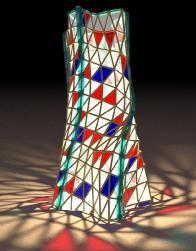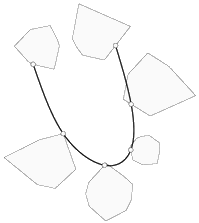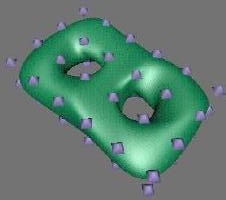|
Geometric Spline Theory
Speaking of geometric splines means a shift of perspective from numerical analysis to geometry. The many geometric properties of well known spline curves become apparent from a geometric theory at a higher level, which usually reveals more of the inner structure of the functions or curves or surfaces already known from other sources. Another major topic in geometric splines is the generalisation of spline curves to manifolds, domains with boundary, and similar nonlinear geometries. Geometric splines are also related to curves defined by intrinsic subdivision processes.
|

|
J. Wallner, M. Hofer, and H. Pottmann. Fair curve networks in nonlinear geometries ACM SIGGRAPH 2005 Conference Abstracts and Applications, August 2005. Fair webs The Visual Computer 23/1 (2007).
Fair curve networks in nonlinear geometries are an extension of our work on energy-minimising spline curves in manifolds. Instead of designing with one single curve, we here present a variational approach for the design with an entire network of curves. After a geometric characterisation of fair, i.e., energy-minimising curve networks, we discuss their discretisation and computation. Fair curve networks in nonlinear geometries have a variety of applications including surface parameterisation, aesthetic remeshing and design of fair surfaces in the presence of obstacles.
|

|
J. Wallner and H. Pottmann: Variational interpolation of subsets. Constr. Approx. 20 (2004), 233-248.
We consider the problem of variational interpolation of subsets of Euclidean spaces by curves such that the L2 norm of the second derivative is minimised. It is well known that the resulting curves are cubic spline curves. We study geometric boundary conditions arising for various types of subsets such as subspaces, polyhedra, and submanifolds, and we indicate how solutions can be computed in the case of convex polyhedra.
|

|
J. Wallner and H. Pottmann: Spline Orbifolds. In: A. Le Méhauté, C. Rabut, L. Schumaker (Eds.) Curves and Surfaces with Applications in CAGD, Vanderbilt University Press, 1997, pp. 445-464.
In order to obtain a global principle for modelling closed surfaces of arbitrary genus, first hyperbolic geometry and then discrete groups of motions in planar geometries of constant curvature are studied. The representation of a closed surface as an orbifold leads to a natural parametrisation of the surfaces as a subset of one of the classical geometries S2, E2, and H2. This well known connection can be exploited to define spline function spaces on abstract closed surfaces and use them e.g. for approximation and interpolation problems.
|
|
|
Publications
-
J. Wallner. Note on curve and surface energies. Technical Report 151, Geometry Preprint Series, Vienna Univ. of Technology, December 2005.
-
M. Hofer, G. Sapiro, and J. Wallner. Fair polyline networks for constrained smoothing of digital terrain elevation data. IEEE Trans. Geosc. Remote Sensing 44/10/2 (2006), 2983-2990.
-
J. Wallner, H. Pottmann, and M. Hofer. Fair curve networks in nonlinear geometries. ACM SIGGRAPH 2005 Conference Abstracts and Applications, August 2005 (electronic).
-
J. Wallner, H. Pottmann, and M. Hofer. Fair webs. The Visual Computer 23/1 (2007), 83-94.
-
J. Wallner. Existence of set-interpolating and energy-minimizing curves. Comput. Aided Geom. Design 21 (2004), 883-892. [MR].
-
J. Wallner. Gliding spline motions and applications. Comput. Aided Geom. Design 21 (2004), 3-21. [MR].
-
J. Wallner and H. Pottmann. Variational interpolation of subsets. Constr. Approx. 20 (2004), 233-248. [MR].
-
J. Wallner and H. Pottmann. Variational interpolation. Technical Report 84, Institut für Geometrie, TU Wien, 2001.
-
J. Wallner. Generalized multiresolution analysis for arc splines. In M. Dæhlen, T. Lyche, and L. L. Schumaker, editors, Mathematical Methods for Curves and Surfaces II, pages 537-544. Vanderbilt University Press, Nashville, 1998, ISBN 0-8265-1315-8. [Zbl], [MR].
-
J. Wallner and H. Pottmann: Spline Orbifolds. In: A. Le Méhauté, C. Rabut, and L. Schumaker, editors, Curves and Surfaces with Applications in CAGD, pages 445-464. Vanderbilt University Press, 1997. [Zbl], [MR].
-
J. Wallner and H. Pottmann. Rational blending surfaces between quadrics. Comput. Aided Geom. Design 14 (1997), 407-419. [MR].
-
J. Wallner. Geometric contributions to surface modeling. PhD thesis, Technische Universität Wien, 1996. Advisor: H. Pottmann.
|
|
|
Quick Links
Johannes Wallner
Discrete Differential Geometry
Developable Surfaces
Nonlinear Subdivision
Geometric Tolerancing
Sitemap
|

